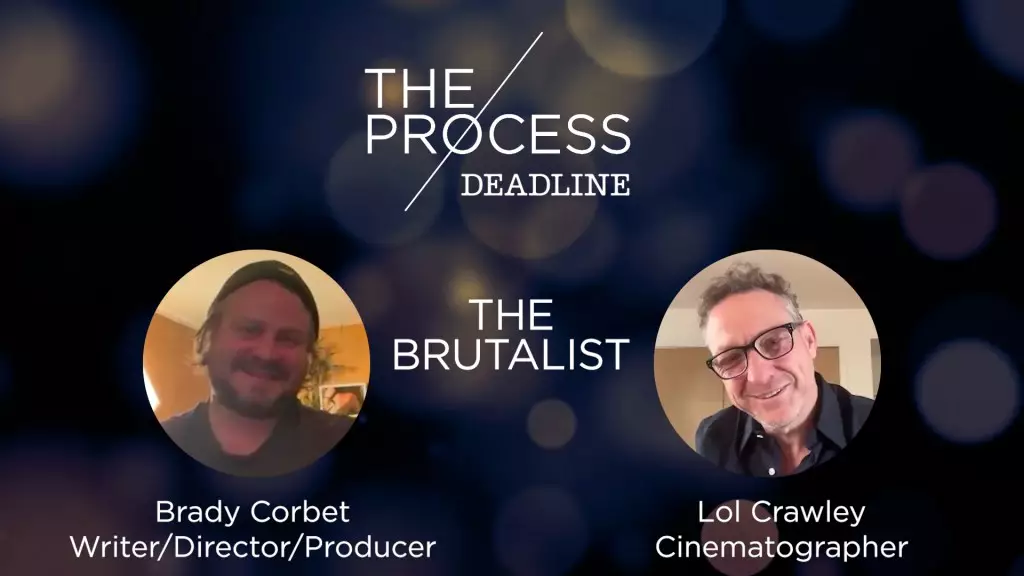“The Brutalist,” directed by Brady Corbet and lensed by cinematographer Lol Crawley, marks their third collaborative effort following the notable successes of “Vox Lux” and “The Childhood of a Leader.” The duo has cultivated a unique synergy over the years, blending distinct creative visions into a cohesive narrative experience. In their discussions about their filmmaking process, they highlight how their past projects have often been perceived as ambitious, evoking both admiration and criticism. Such duality provides insight into the fine line between artistic ambition and audience reception—a theme that resonates throughout many creative endeavors.
Corbet reflects on his writing approach, revealing a paradox where the world he envisions while crafting a screenplay might initially feel constricted. He describes this phenomenon using a visual metaphor, expressing a sense that his ideas emerge from a ‘very small circle’ before expanding during production. This perspective shifts the focus from the solitary act of writing to the collaborative environment of filmmaking, where numerous contributions transform a confined concept into a grand tapestry of storytelling. His acknowledgment of the collective effort underscores a vital aspect of filmmaking: it is not simply a solitary creator’s vision but a confluence of diverse talents that propel a film to its final form.
The language of cinema is a recurring theme in Corbet and Crawley’s dialogue, as they dissect what it means to create ambitious scenes and how individual shots evolve into a larger narrative. Crawley emphasizes that true cinematic moments arise not only from carefully choreographed visuals but also from the nuanced interplay between space and performance. The cinematic language, while frequently perceived as elusive or overused, becomes a conduit through which they channel their artistic aspirations. Each shot captures emotions and dynamics that resonate with audiences, creating a shared experience between the film and its viewers.
Their insights reveal a profound understanding of the filmmaking process, with a specific focus on how ambition manifests through execution. The idea that every moment must be steeped in meaning and artistry is crucial in shaping a film’s identity. The ambition to craft “The Brutalist” as a visually stunning piece reflects their commitment to not just telling a story, but doing so in a way that engages viewers on multiple sensory levels.
Filmmaking is often romanticized, yet Corbet and Crawley offer an unvarnished glimpse into the grueling nature of production life. Corbet’s candidness about the toll of long hours, sleepless nights, and the relentless pace of on-set dynamics paints a vivid picture of the challenges filmmakers face. This behind-the-scenes reality is a stark contrast to the polished final product that the audience experiences. Such honesty sheds light on the often overlooked aspect of the film industry: the human cost of creativity.
Crawley further elaborates on the atmosphere of a film set, describing it as a peculiar and repetitive environment that might be bewildering for outsiders. His observation about how visitors may struggle to understand the dedication required from the cast and crew emphasizes a cultural gap between those who create and those who consume. It acknowledges that the filmmaking process, though fraught with tension, is driven by an underlying passion for storytelling—an experience typically imbued with both exhaustion and exhilaration.
Set in the post-World War II era, “The Brutalist” explores the poignant narrative of László Tóth, portrayed by Adrien Brody. Tóth’s journey as a Hungarian-Jewish architect embodies themes of resilience and hope, reflecting on the personal tragedies of the Holocaust while navigating his aspirations in a new world. As he awaits the arrival of his wife Erzs Bet and niece Zsófia, played by Felicity Jones and Raffey Cassidy respectively, the film intricately weaves a story of love and longing against a backdrop of historical trauma.
With numerous accolades, including a Best Motion Picture Drama win at the Golden Globes and multiple Oscar nominations, “The Brutalist” not only defies genre conventions but also elevates the discourse on the complexity of the human experience. The film’s success is an affirmation of its resonant storytelling and potent themes, solidifying its place in contemporary cinema.
The collaboration of Corbet and Crawley is a testament to the transformative power of filmmaking—a medium that thrives on collective creativity and shared vision. As “The Brutalist” unfolds within the delicate balance of ambition and reality, it serves as a reminder of the intricate dance between artistic expression and the emotional truths that bind humanity. In dissecting their own artistic processes, Corbet and Crawley invite audiences to appreciate the film not just as entertainment but as a profound exploration of the delicate threads that weave together art and life.


Leave a Reply